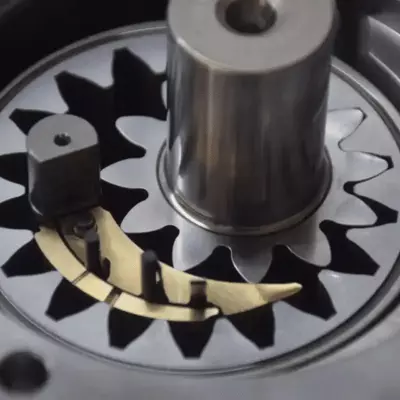The Working Principle of an Internal Gear Pump
The working principle of an internal gear pump (also known as a internal meshing gear pump) is primarily based on its unique gear design. This type of pump typically consists of a pair of intermeshing gears, one being an external (large) gear and the other an internal (small) gear, which are mounted within a pump housing and interlock with each other. Here is a detailed operational description of the working principle of an Internal gear pump:

Initial State:
At the outset, the internal gear pump operates with its moving parts fully immersed in the liquid to be pumped. The spaces between the gear teeth, as well as the clearance between the gears and the pump casing, are filled with fluid. This initial saturation helps prevent fluid from leaking while ensuring smooth operation from the moment the pump starts.
Gear Rotation:
As the pump begins operation, the external (large) gear and the internal (small) gear start to rotate in opposite directions. Since the two gears have a different number of teeth, the spaces between them change dynamically as they rotate. This change in volume plays a crucial role in the suction and discharge process, which is fundamental to how a gear pump work.
Liquid Suction:
During rotation, the spaces between the gear teeth on the suction side gradually expand, creating a negative pressure zone. This vacuum effect draws liquid into the pump through the suction inlet. The ability to generate and maintain this suction is a key advantage of gear pump designs, especially when handling high viscosity fluids, where consistent fluid movement is essential.
Liquid Compression and Discharge:
As the gears continue to rotate, the spaces between the teeth start to contract. This compression forces the liquid to move towards the discharge side, where it is expelled at high pressure. The ability to maintain a steady and controlled outflow makes internal gear pump designed solutions highly effective for appliCations requiring precise fluid delivery.
Continuous Operation:
Unlike reciprocating pumps, which rely on back-and-forth motion, an internal gear pump operates with continuous rotation. This ensures an uninterrupted flow of liquid, making it ideal for industrial processes that demand a stable and efficient pumping mechanism. The absence of abrupt start-stop cycles reduces mechanical stress, enhancing the longevity of the pump.
Sealing and Lubrication:
A well-designed gear pump work mechanism ensures tight clearance between the gears and the pump casing, minimizing energy loss and preventing fluid from leaking. Additionally, the very liquid being pumped serves as a natural lubricant, reducing friction and wear between the moving parts. This self-lubricating characteristic extends the pump’s lifespan and enhances reliability.
Flow and Pressure Regulation:
The performance of an internal gear pump can be adjusted by modifying key parameters such as rotational speed, the number of gear teeth, and the internal geometry of the pump casing. These adjustments allow the pump to operate efficiently across various applications, from handling thin industrial oils to high viscosity fluids like resins and adhesives.
Conclusion:
In summary, an internal gear pump operates on the principle of continuous fluid displacement, achieved through its innovative gear pump designs. By leveraging the controlled expansion and contraction of spaces between the gear teeth, it ensures reliable suction, compression, and discharge of liquid. Unlike reciprocating pumps, which rely on cyclic movement, an internal gear pump designed for steady rotation provides a consistent, efficient, and versatile solution for handling a wide range of fluids, from low-viscosity oils to high viscosity fluids in industrial settings.
To learn more about gear pump products, please visit our gear pump product page.



